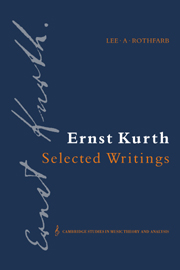Book contents
- Frontmatter
- Contents
- Foreword by Ian Bent
- Preface
- Notes on the translation
- Introduction
- Part I Grundlagen des linearen Kontrapunkts (Foundations of linear counterpoint)
- Part II Romantische Harmonik und ihre Krise in Wagners “Tristan” (Romantic harmony and its crisis in Wagner's “Tristan”)
- Part III Bruckner
- Appendix: Complete tables of contents for Kurth's Grundlagen des linearen Kontrapunkts, Romantische Harmonik und ihre Krise in Wagners “Tristan” and Bruckner
- Select bibliography
- Index of musical examples
- General index
Foreword by Ian Bent
Published online by Cambridge University Press: 10 December 2009
- Frontmatter
- Contents
- Foreword by Ian Bent
- Preface
- Notes on the translation
- Introduction
- Part I Grundlagen des linearen Kontrapunkts (Foundations of linear counterpoint)
- Part II Romantische Harmonik und ihre Krise in Wagners “Tristan” (Romantic harmony and its crisis in Wagner's “Tristan”)
- Part III Bruckner
- Appendix: Complete tables of contents for Kurth's Grundlagen des linearen Kontrapunkts, Romantische Harmonik und ihre Krise in Wagners “Tristan” and Bruckner
- Select bibliography
- Index of musical examples
- General index
Summary
Theory and analysis are in one sense reciprocals: if analysis opens up a musical structure or style to inspection, inventorying its components, identifying its connective forces, providing a description adequate to some live experience, then theory generalizes from such data, predicting what the analyst will find in other cases within a given structural or stylistic orbit, devising systems by which other works – as yet unwritten – might be generated. Conversely, if theory intuits how musical systems operate, then analysis furnishes feedback to such imaginative intuitions, rendering them more insightful. In this sense, they are like two hemispheres that fit together to form a globe (or cerebrum!), functioning deductively as investigation and abstraction, inductively as hypothesis and verification, and in practice forming a chain of alternating activities.
Professionally, on the other hand, “theory” now denotes a whole subdiscipline of the general field of musicology. Analysis often appears to be a subordinate category within the larger activity of theory. After all, there is theory that does not require analysis. Theorists may engage in building systems or formulating strategies for use by composers; and these almost by definition have no use for analysis. Others may conduct experimental research into the sound-materials of music or the cognitive processes of the human mind, to which analysis may be wholly inappropriate. And on the other hand, historians habitually use analysis as a tool for understanding the classes of compositions – repertories, “outputs,” “periods,” works, versions, sketches, and so forth – that they study.
- Type
- Chapter
- Information
- Ernst Kurth: Selected Writings , pp. xi - xiiPublisher: Cambridge University PressPrint publication year: 1991



